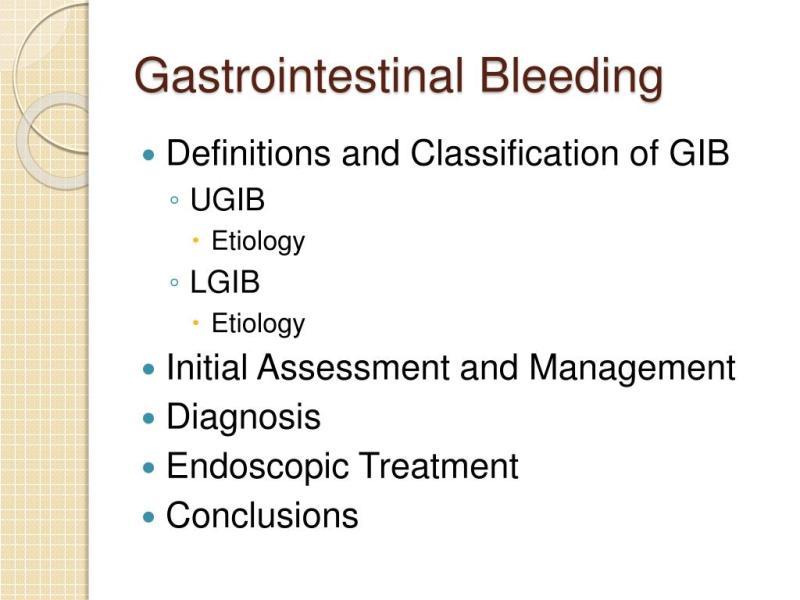What is gastrointestinal (GI) bleeding?
Gastrointestinal (GI) bleeding refers to bleeding that occurs within the digestive tract, which includes the esophagus, stomach, small intestine, large intestine (colon), rectum, and anus. GI bleeding can manifest as bleeding in various parts of the digestive system, and it can range from mild to severe. The bleeding may be visible in the form of blood in the vomit or stools, or it may be occult (not visible to the naked eye).
Causes of Gastrointestinal Bleeding:
Peptic Ulcers: Open sores that develop on the inner lining of the stomach, upper small intestine, or esophagus.
Gastritis: Inflammation of the stomach lining.
Esophageal Varices: Enlarged veins in the esophagus, often associated with liver disease.
Mallory-Weiss Tears: Tears in the mucous membrane that connects the esophagus to the stomach, often due to severe vomiting.
Gastrointestinal Cancers: Tumors in the digestive system, such as stomach cancer or colorectal cancer.
Diverticulosis: Small pouches (diverticula) that can form in the walls of the intestines, which may bleed if they become inflamed or infected.
Inflammatory Bowel Disease (IBD): Conditions like Crohn's disease or ulcerative colitis can cause inflammation and bleeding in the digestive tract.
Angiodysplasia: Abnormal blood vessels in the GI tract that can rupture and cause bleeding.
Hemorrhoids: Swollen blood vessels in the rectum or anus that can bleed.
Gastrointestinal Infections: Infections caused by bacteria or viruses that can lead to inflammation and bleeding.
Medication Side Effects: Certain medications, such as nonsteroidal anti-inflammatory drugs (NSAIDs) or blood thinners, may contribute to GI bleeding.
Symptoms of Gastrointestinal Bleeding:
The symptoms of GI bleeding can vary depending on the location and severity of the bleeding. Common symptoms include:
Bright Red or Dark, Tarry Stools: Depending on the location of bleeding in the digestive tract, blood may be visible in the stool.
Vomiting Blood (Hematemesis): Blood may be present in vomit, appearing red or resembling coffee grounds.
Weakness and Fatigue: Anemia resulting from chronic blood loss can lead to weakness and fatigue.
Abdominal Pain or Discomfort: Pain or discomfort in the abdominal area may be present, especially if there is inflammation or an underlying condition.
Pale Skin: Anemia can cause a pale complexion.
Dizziness or Lightheadedness: Reduced blood volume from bleeding can lead to dizziness.
Rapid Heart Rate: An increased heart rate may occur as the body compensates for decreased blood volume.
Gastrointestinal bleeding requires prompt medical attention. If you suspect GI bleeding based on symptoms such as bloody stools, vomiting blood, or signs of anemia, seek medical help immediately. Diagnostic tests, such as endoscopy, colonoscopy, or imaging studies, may be performed to identify the source of bleeding and determine an appropriate treatment plan. Treatment depends on the underlying cause and may involve medications, endoscopic procedures, or surgery.
1. Definition of Gastrointestinal (GI) Bleeding
Gastrointestinal (GI) bleeding, also known as digestive hemorrhage, refers to any bleeding that occurs within the gastrointestinal tract, which is the long, tube-like system responsible for digesting and absorbing nutrients from food. GI bleeding can range from mild to severe and can occur anywhere along the GI tract, from the mouth to the anus.
2. Symptoms and Signs of GI Bleeding
The symptoms and signs of GI bleeding can vary depending on the location and severity of the bleeding. However, some common symptoms include:
Blood in the stool (hematochezia): This is the most common sign of GI bleeding and can range from bright red to black, depending on the location of the bleeding.
Vomiting blood (hematemesis): This indicates bleeding in the upper GI tract, such as the esophagus, stomach, or duodenum.
Tarry stools (melena): This occurs when blood in the upper GI tract digests and turns black before passing in the stool.
Abdominal pain
Nausea
Dizziness
Lightheadedness
Fainting
3. Categorization and Diagnosis of GI Bleeding
GI bleeding is typically categorized based on the location of the bleeding:
Upper GI bleeding (UGIB): This refers to bleeding that occurs in the upper part of the GI tract, including the esophagus, stomach, and duodenum.
Lower GI bleeding (LGIB): This refers to bleeding that occurs in the lower part of the GI tract, including the small intestine, colon, rectum, and anus.
Diagnosing GI bleeding involves a thorough medical history, physical examination, and diagnostic tests. Common diagnostic tests include:
Upper endoscopy: This procedure uses a thin, flexible tube with a camera to visualize the lining of the esophagus, stomach, and duodenum.
Colonoscopy: This procedure uses a thin, flexible tube with a camera to visualize the lining of the colon and rectum.
Capsule endoscopy: This procedure involves swallowing a small capsule containing a camera that takes pictures of the lining of the small intestine.
Angiography: This procedure uses X-rays and a dye injected into the bloodstream to visualize blood vessels and identify potential bleeding sites.
Stool tests: These tests can detect hidden blood in the stool, even if it is not visible to the naked eye.
Once the location and severity of the bleeding have been determined, the doctor can recommend appropriate treatment options.












